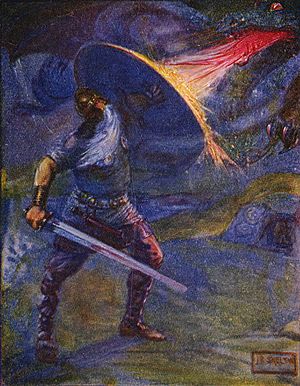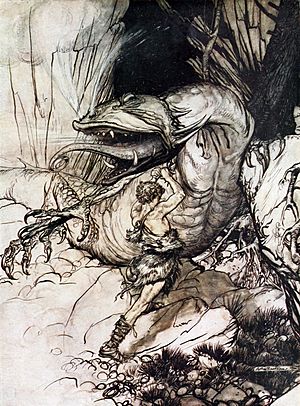The dragon (Beowulf) facts for kids

In the old Anglo-Saxon poem Beowulf, the hero Beowulf faces a powerful dragon. This is the third monster he fights in the long epic story. After returning from Heorot, where he defeated Grendel and Grendel's mother, Beowulf becomes king of the Geats. He rules his people wisely for fifty years.
One day, a slave accidentally wakes up the dragon. The slave had stolen a special jewelled cup from the dragon's hidden home. The angry dragon then burns the homes and lands of the Geats. Beowulf decides to fight and kill the monster himself. He and his brave warriors, called thanes, go to the dragon's lair. But when they see the huge beast, most of the thanes run away in fear. Only Wiglaf stays to fight by Beowulf's side. The dragon badly wounds Beowulf. Wiglaf then attacks the dragon with his sword, and Beowulf finishes it off with his dagger.
This story helped shape how we think of dragons today. Beowulf is the first English story to feature a dragonslayer. The Beowulf dragon has many features from older Germanic myths. But the poet was the first to combine them into a unique fire-breathing dragon. This dragon also inspired J. R. R. Tolkien's dragon in The Hobbit (1937). The Hobbit is a very important book in modern high fantasy stories.
The dragon fight happens near the end of the poem. It shows Beowulf's final stand against evil. As the hero, he knows that if he fails, his people will suffer. The dragon acts like a greedy "gold-king." It attacks Beowulf's kingdom because of one stolen cup. The fight scene is told in three parts. It ends with the deaths of both the dragon and Beowulf.
Contents
The Story of Beowulf's Last Fight
After his tough battles against Grendel and Grendel's mother, Beowulf goes back home. He becomes the king of the Geats. Fifty years pass peacefully with Beowulf as king. Then, a local dragon gets very angry. A slave had entered its secret home and taken a valuable cup from its treasure.
The dragon attacks nearby towns to get revenge. Beowulf and a group of his men go to find the dragon's lair. Beowulf tells his men to wait outside. He says this fight is his alone. But the dragon is very strong and wounds Beowulf badly. Meanwhile, Beowulf's relative, Wiglaf, scolds the other warriors. He tells them off for not helping their king. Then, Wiglaf bravely goes to help Beowulf. He cuts the dragon in its belly to reduce its flames. Beowulf then delivers the final, deadly blow. As he dies, Beowulf names Wiglaf as his heir. He also asks for a monument to be built for him by the sea.
Where the Dragon Story Comes From

Beowulf is the oldest surviving heroic poem in the English language. It is also the first to show a dragon slayer. Stories of dragon slayers already existed in Norse sagas. One famous tale is about Sigurd and Fafnir. The Beowulf poet used ideas and themes common in dragon stories.
Beowulf is the earliest Anglo-Saxon story we have that features a dragon. The poet might have known similar stories from Germanic legends. Old Germanic writings and Christian saint stories also had dragons. They often showed fights with dragons. Even though dragons in saint stories were less fierce, they shared some ideas. These included journeys to the dragon's home, scared onlookers, and messages about the fight's outcome.
The idea of a dragon guarding treasure is common in early Germanic stories. It appears in Norse sagas, especially in the Völsunga saga and in Beowulf. Beowulf keeps alive many old dragon myths. It even tells the story of Sigurd and Fafnir. But other stories from that time did not have the same detail as Beowulf's dragon scene. Beowulf is a hero who had already killed two monsters. The scene includes memories of past wars. It also has a detailed description of the dragon and its treasure. The story ends with beautiful funeral images.
J. R. R. Tolkien, a famous Beowulf expert, thought the dragon in Beowulf was one of only two "real" dragons in northern European literature. He wrote that dragons important to a story are rare. He said only the dragon of the Völsungs, Fáfnir, and Beowulf's dragon truly matter. Tolkien believed the Beowulf poet focused on the monsters. He saw the dragon as a key part of the story's plot. Tolkien later used ideas from Beowulf's dragon in his own books. This shows how much the poem influenced him.
What the Dragon is Like
The Beowulf dragon is the first example in literature of a typical European dragon. It is also the first time a fire-breathing dragon appears. The Beowulf dragon is called draca (dragon) and wyrm (reptile or serpent) in Old English. It is also described as having a poisonous bite. The Beowulf poet gave the dragon special traits. It is a creature that comes out at night. It loves to hoard treasure, is curious, and seeks revenge. And, of course, it breathes fire.
The dragon's fire might represent the hellfire of the devil. It reminds us of the monster in the Book of Job from the Bible. In an old Greek version of the Bible, Job's monster is called a draco. It is linked to the devil. The author of Beowulf likely knew about Job's dragon. It was a Christian symbol of evil. It was seen as a great enemy of God, humans, and animals.
Studies of German and Norse texts show three main reasons for a dragon slayer's fight. These are fighting for treasure, saving one's people, or freeing a woman. The traits of Beowulf's dragon seem unique to the poem. The poet may have mixed different dragon ideas. This created a dragon with special traits that fit the story's complex plot.
Why the Dragon is Important
The third part of the poem is different from the first two. In Beowulf's earlier fights, Grendel and Grendel's mother are described as coming from Cain. They seem human-like, like giants, trolls, or monsters. The dragon is very different from these two enemies.
Also, the dragon is much more destructive. It burns large areas and the homes of the Geats. The poem says, "the dragon began to belch out flames / and burn bright homesteads." Beowulf's fight with the dragon has been called either a selfless act or a reckless one. Unlike his earlier battles, this fight happens in Beowulf's own kingdom. It also ends in defeat for him. He had won against the other monsters far from home.
The dragon fight is hinted at earlier in the poem. For example, in the funeral of Scyld Shefing and the story of Sigmund's death by a dragon. A Beowulf expert named Alexander says the dragon fight likely shows Beowulf's (and society's) battle against evil. The fate of the people depends on this fight. As a hero, Beowulf must bravely face death.
Beowulf's death from the dragon hints at "warfare, death, and darkness" for his Geats. The dragon's treasure represents an older society. This society was lost to wars and hunger. Only one survivor from that time left the treasure behind. Beowulf's imagined funeral song hints at his own death and funeral to come. Before he faces the dragon, Beowulf thinks about his past. He remembers his childhood and the wars the Geats fought. This also hints at the future. When he dies, peace in his lands will end. His people will again face war and hardship.
A society struggling without "social cohesion" is shown by the greedy dragon guarding its gold. The funeral song for Beowulf becomes a song for the whole culture. The dragon's treasure represents a lost and ancient people. This is compared to the Geatish people, whose history is new and short-lived. As king, Beowulf defends his people against the dragon. When his warriors leave him, the poem shows a "heroic society" falling apart. This society relies on loyalty between a lord and his warriors.
Wiglaf stays loyal to his king. He remains to fight the dragon. This part of the story is like the tale of Beowulf's hero Sigemund and his friend. Wiglaf is a younger companion to Beowulf. His courage shows he is Beowulf's true successor. Having a companion is a common idea in other dragon stories. But the Beowulf poet breaks from old traditions. The hero suffers greatly (hacking, burning, stabbing) and then dies. Also, the dragon is defeated because of Wiglaf's actions. Even though Beowulf dies fighting, the dragon is killed by his companion.
The dragon battle is structured in three parts. These are the preparation, the events before the fight, and the battle itself. Wiglaf kills the dragon halfway through the scene. Beowulf's death happens "after two-thirds" of the scene. The dragon attacks Beowulf three times. As Tolkien wrote in Beowulf: The Monsters and the Critics (1936), death by a dragon "is the right end for Beowulf." He believed that "a man can but die upon his death-day."
How the Dragon Influenced Other Stories
In their book From Homer to Harry Potter: A Handbook on Myth and Fantasy, Matthew Dickerson and David O'Hara say that the Beowulf poet added the dragon to a "pot" of ideas. This "pot" is used by most modern fantasy writers. They argue that many works with evil dragons, and even stories with friendly dragons, were influenced by Beowulf's dragon. Examples include the My Father's Dragon books and the Pern series by Anne McCaffrey.
Dickerson and O'Hara also said that Beowulf's dragon made the idea of fighting a "monstrous evil" a key part of modern fantasy. This is seen in C. S. Lewis' Narnia books, Ursula K. Le Guin's Earthsea books, and the Thomas Covenant series by Stephen Donaldson.
J. R. R. Tolkien used the dragon story from Beowulf as a model for Smaug in The Hobbit. In both stories, the dragon wakes up when someone disturbs its treasure by stealing a cup. It then goes on a furious rampage until someone kills it. Aia Hussein from the National Endowment for the Humanities wrote that the fight between Harry Potter and the Hungarian Horntail in Harry Potter and the Goblet of Fire (2000) was influenced by the fight between Beowulf and his dragon.
In the 2007 film version, the dragon is Grendel's younger half-brother. He is the son of Grendel's mother and Beowulf. This means Beowulf ironically ends up killing his own son at the end of the movie.


